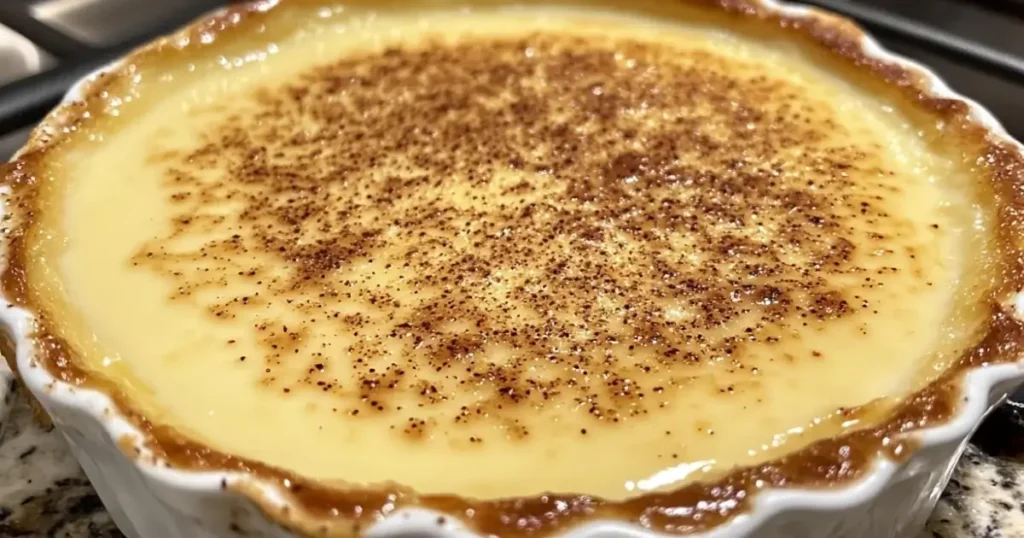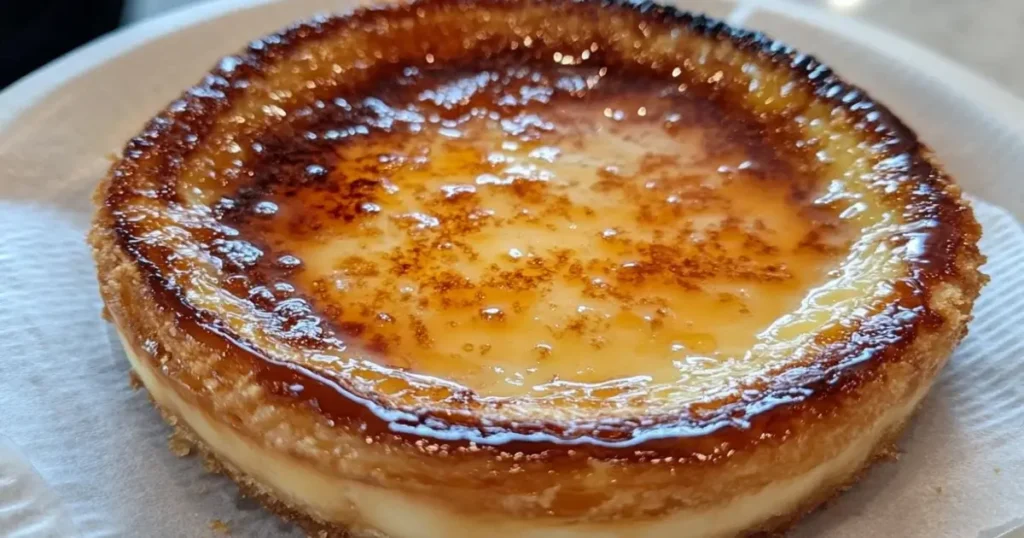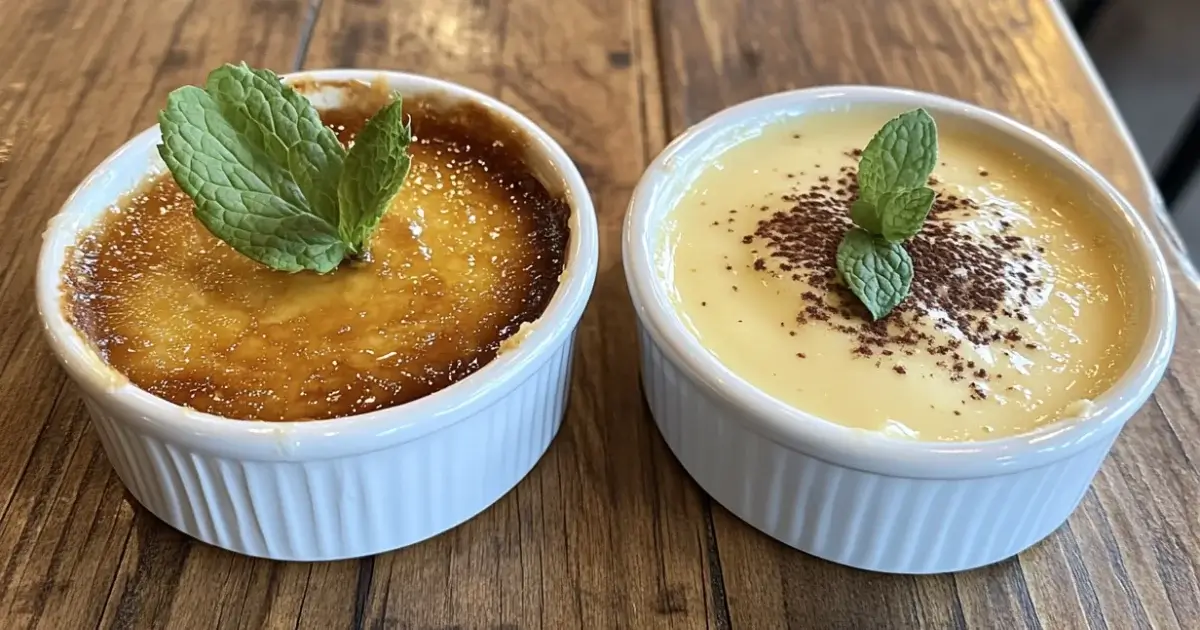Last Updated on May 9, 2025 by Souhail
Ever wondered what’s the difference between crème brûlée and custard? You’re not alone, they’re both creamy, dreamy, and made with similar ingredients like eggs, sugar, and cream. But the key difference lies in the finish. Crème brûlée is all about that iconic crackly caramelized sugar top, torched to golden perfection, while custard is smooth all the way through with no crunchy topping in sight.
Texture and presentation also set them apart. Crème brûlée is typically baked in individual ramekins and chilled before getting its signature sugar crust, while custards can be served warm or cold, and vary in thickness depending on how they’re cooked. Both are absolutely delicious, but if you love a bit of drama with your dessert, that burnt-sugar top might just win you over!
Table of contents
Crème Brûlée vs. Custard: A Delicious Comparison
At the heart of the debate lies a simple question: Is crème brûlée just a custard in disguise? The short answer is yes and no. Crème brûlée is indeed a type of custard, but its preparation and final flourish distinguish it from its simpler counterpart.
What is Custard?

Cooks create custard by combining and cooking eggs, milk or cream, and sugar. The texture ranges from runny and pourable to firm and sliceable, depending on the recipe and the ratio of eggs to liquid. People often make custards as sweet or savory dishes, although the sweet versions dominate desserts.
Technically, custards rely on their cooking method for definition. Cooks gently heat the mixture to thicken it, either on the stovetop or in an oven. Classic desserts like flan, crème caramel, and baked custard pudding all exemplify this category.
The Basics of Custard: Custard can be divided into two main types:
- Stovetop Custard: Cooks prepare stovetop custard, often called crème anglaise, by thickening it on the stovetop. They use it as a sauce or a base for other desserts.
- Baked Custard: Cooks bake custard in the oven to achieve a firmer texture, typically serving it as a standalone dessert.
Flavor Profile and Texture: Custard boasts a creamy, delicate flavor that lets the richness of the milk and eggs shine. The texture is smooth and velvety, perfect for layering in trifles or as a standalone treat.
Custard in Everyday Desserts: Custard is the unsung hero of desserts like flan, bread pudding, and fruit tarts. Its versatility makes it an essential component in both simple and elaborate recipes.
What is Crème Brûlée?

Crème brûlée, French for “burnt cream,” elevates custard to luxury. It features a creamy vanilla custard base topped with caramelized sugar. The hallmark of this dessert is its contrasting textures: a crackling caramel crust over silky custard.
The sugar crust forms by sprinkling granulated sugar on the custard and caramelizing it with a kitchen torch or broiler. This step adds a crunchy texture and a rich, slightly bitter note that balances the dessert’s sweetness.
Flavor Profile and Texture: Crème brûlée is rich, indulgent, and sophisticated. The custard base is denser than traditional custard, and the caramelized topping adds complexity and crunch.
The Components of Crème Brûlée: Crème brûlée shares the same basic ingredients as custard, eggs, sugar, and cream, but the process and presentation are what make it unique. Key differences include:
- Dairy Choice: Crème brûlée almost exclusively uses heavy cream, resulting in a denser, more luxurious texture.
- Egg Yolk Focus: Only yolks are used, giving the custard base its rich, silky finish.
- Caramelized Topping: A thin layer of sugar is torched to form a crisp, caramelized crust just before serving.
The Art of the Crunch: The defining feature of crème brûlée is its sugar crust, achieved with a kitchen torch or broiler. This step is as much about presentation as it is about flavor. The caramelization process adds depth, with hints of bitterness balancing the dessert’s sweetness.
A Feast for the Senses: Crème brûlée is a multi-sensory experience. The sound of the sugar crust cracking under a spoon, the smooth custard beneath, and the interplay of textures and flavors make it a favorite for special occasions.
Looking to take your crème brûlée game to the next level? Don’t miss our unique twist on this classic dessert with our Crab Crème Brûlée Recipe!
Crème Brûlée vs. Custard: Side-by-Side Comparison
When comparing crème brûlée and custard, their shared foundation of eggs, sugar, and dairy makes them appear similar at first glance. However, a closer examination reveals key differences in ingredients, cooking methods, texture, and presentation that set them apart. In this section, we’ll break down these distinctions to give you a clear, side-by-side comparison of these beloved desserts.
Ingredients
- Custard: Eggs (whole or yolks), sugar, and milk or cream.
- Crème Brûlée: Egg yolks, sugar, and heavy cream.
Cooking Methods
- Custard: Cooked on the stovetop (crème anglaise) or baked (traditional custard).
- Crème Brûlée: Always baked in a water bath to ensure even cooking.
Texture
- Custard: Ranges from light and pourable to firm and sliceable.
- Crème Brûlée: Always rich and creamy, with a crunchy sugar topping.
Presentation
- Custard: Typically unadorned or topped with fruit or a dusting of spices.
- Crème Brûlée: Features a caramelized sugar crust for a polished, restaurant-quality look.
Why These Desserts Work: A Breakdown
Shared Ingredients, Unique Outcomes
Both crème brûlée and custard rely on a simple base of eggs, sugar, and dairy. The magic lies in the technique and the subtle variations that transform these ingredients into entirely different experiences. Here’s a closer look:
- Eggs: The primary thickening agent in both desserts, eggs give custards their smooth texture. In crème brûlée, the egg yolks are often used without whites, lending the dessert its luxurious richness.
- Dairy: Milk creates a lighter custard, while cream is favored for crème brûlée to achieve a denser, more decadent texture.
- Cooking Method: Custard can be cooked on the stovetop or baked, while crème brûlée is always baked in a water bath to ensure even cooking.
- Sugar: In custard, sugar is incorporated into the mix, while in crème brûlée, it also plays a starring role in the crunchy topping.
The Role of Texture and Presentation
One of the most notable differences lies in the sensory experience. Custard is unadorned and comforting, with its smooth texture taking center stage. Crème brûlée, on the other hand, engages multiple senses, the satisfying crack of the sugar crust, the creamy interior, and the interplay of bitter and sweet flavors.
The Origins and Cultural Significance of Crème Brûlée and Custard
The History of Custard
Custard dates back to ancient Rome, where the discovery of eggs’ thickening properties led to the creation of early custard-like dishes. Over centuries, custard became a culinary staple across Europe, with variations appearing in both savory and sweet forms.
The Story of Crème Brûlée
Crème brûlée, though often associated with French cuisine, has a debated origin. Some historians trace it to Catalonia (where it is known as crema catalana), while others credit England or France. Regardless of its birthplace, crème brûlée has become synonymous with sophistication and indulgence.
Whether you’re a die-hard fan of the rich and crunchy crème brûlée or you prefer the understated charm of custard, both desserts deserve a spot on your table. Each offers its own unique take on creamy, indulgent sweetness, showcasing the magic of simple ingredients transformed by technique and creativity.
If you’re inspired to whip up these classics at home, you’ll find that both are surprisingly approachable with the right tools and tips. Try custard for a crowd-pleasing comfort dessert or impress your guests with the show-stopping flair of crème brûlée. No matter which you choose, you can’t go wrong.
Now it’s your turn to weigh in, are you team crème brûlée, team custard, or both? Share your thoughts and dessert-making adventures in the comments below. And if you’re looking for more dessert inspiration, check out our Pizzelle Recipe or Fried Apples Recipe.

